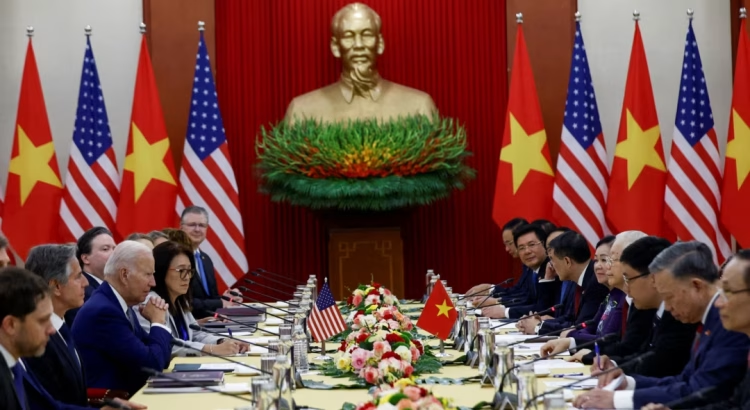Dai Phat Thanh Vietnam – As 2025 unfolds, Vietnam finds itself walking a geopolitical tightrope unlike any other Southeast Asian nation. With rising tensions in the Indo-Pacific and intensifying rivalry between China and the United States, Vietnam’s strategic balancing act is being tested on every front. From economic partnerships to security cooperation, the Vietnamese government is navigating a complex web of diplomacy to preserve sovereignty while advancing its national interests.
Vietnam has a long history of managing great-power relationships with caution and skill. But in today’s rapidly shifting global landscape, Vietnam’s strategic balancing act is drawing international attention for both its subtleties and high-stakes implications. Whether it’s trade deals with the West or border negotiations with China, every move matters—and the world is watching.
The China Challenge: Proximity, History, and Pressure
China looms large in Vietnam’s geopolitical calculations. Sharing a 1,400-kilometer land border and contested waters in the South China Sea, the two nations are bound by history, ideology, and geography. Yet, these ties have often been strained. In 2025, territorial disputes over the Paracel and Spratly Islands remain unresolved, further complicating strategic balancing act in dealing with Beijing.
While China is Vietnam’s largest trading partner, Hanoi remains wary of economic overdependence. The influx of Chinese capital in sectors like real estate and infrastructure has fueled both growth and concern. Vietnam is seeking to diversify trade while reinforcing maritime security through multilateral diplomacy—a core element of Vietnam’s strategic balancing act that seeks to contain Chinese influence without direct confrontation.
Pivoting Westward: Opportunities and Risks
On the other side of the balance is Vietnam’s engagement with the West, particularly the United States, European Union, and regional partners like Japan and Australia. These nations view Vietnam as a vital counterweight to China in Southeast Asia. As a result, Vietnam’s strategic balancing act increasingly involves deepening defense ties, expanding trade deals, and welcoming diplomatic overtures without appearing to align with any bloc.
Vietnam’s role in the Indo-Pacific Economic Framework (IPEF) and its strengthening of military cooperation with the US Navy show this delicate calibration in real time. However, aligning too closely with the West risks provoking retaliation from China. Thus, Vietnam’s strategic balancing act requires finesse—leveraging Western support while maintaining an image of neutrality.
The ASEAN Factor: Multilateralism as a Buffer
Vietnam’s active role within ASEAN serves as a protective cushion in its foreign policy. By championing unity and peaceful conflict resolution, Hanoi promotes multilateralism as part of Vietnam’s strategic balancing act in 2025. ASEAN forums provide Vietnam with a platform to voice maritime concerns, support economic integration, and defuse bilateral tensions through regional consensus.
Additionally, Vietnam’s chairmanship of several ASEAN subcommittees this year enables it to guide agenda-setting on issues like cybersecurity, green transition, and cross-border trade. This reinforces its diplomatic clout while anchoring Vietnam’s strategic balancing act in collective regional interests rather than risky unilateral maneuvers.
Economic Diplomacy and Technological Shifts
Vietnam’s economic engine is humming, with high-tech manufacturing and green energy attracting global investment. Major tech firms from the US, South Korea, and Europe are establishing operations in Vietnam to diversify supply chains away from China. This economic momentum is a vital part of Vietnam’s strategic balancing act, as the country becomes a top alternative to China for global business.
Yet, the same trend invites scrutiny from Beijing, which views Western technological alliances as potential threats. Vietnam must manage these partnerships carefully, ensuring that new investments align with national security and long-term development goals. In short, Vietnam’s strategic balancing act involves maximizing economic opportunity while minimizing strategic vulnerability.
Public Sentiment and National Identity
Domestic sentiment in Vietnam plays a critical role in shaping foreign policy. Historical memory of Chinese invasions and a strong sense of national sovereignty inform public opinion about Hanoi’s diplomatic stance. The Vietnamese population supports an assertive posture on maritime sovereignty and a diversified economy, but also values peace and political stability. Thus, Vietnam’s strategic balancing act must reflect internal aspirations as much as external pressures.
In 2025, social media and independent commentators increasingly shape discourse on foreign affairs. Public scrutiny means that any perceived tilt toward one power over another can spark criticism. Navigating public opinion has therefore become another dimension of Vietnam’s strategic balancing act, especially as younger generations demand transparency and national pride in foreign relations.
A Defining Moment for Vietnam’s Global Role
As superpower rivalries escalate, smaller nations like Vietnam face enormous challenges—and unique opportunities. The ability to maintain autonomy without alienating major partners is rare and difficult. Yet, Vietnam’s strategic balancing act shows the world that careful diplomacy, regional integration, and economic diversification can chart a path forward even in turbulent times.
Vietnam’s handling of its relationship with both China and the West may serve as a model for other nations caught in similar strategic crossfires. How it manages this balance in the next few years will not only shape domestic development but also impact Southeast Asia’s broader geopolitical landscape.



